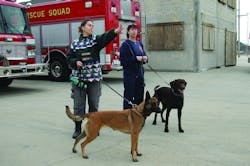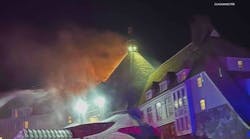We’ve all been there. You’ve had a major fire in a large abandoned building with an unknown number of transients living in it. You know that at least 20 people were in the building when the fire started, but you saw only five come out during firefighting operations. You must check it out – even though it means taking four or five companies out of service for several hours to comb through the building with rakes, shovels and pike poles.
In 2006, when the New Orleans Fire Department’s Urban Search and Rescue (USAR) team was tasked with recovering human remains in the Lower 9th Ward as a result of Hurricane Katrina the previous year, the main search tools were canine search teams from all over the country. When New Orleans firefighters were faced with a post-fire problem similar to the one described above, it was suggested to use one of the canines from the Lower 9th Ward to search the building. That search was accomplished successfully within an hour.
In succeeding months, the fire department developed a Memorandum of Agreement (MOA) with a volunteer canine search group, Louisiana Search and Rescue (LASAR). The MOA states that when requested by the New Orleans Fire Department, LASAR will send canines and establish points of contact. It also delineated the support that the fire department will provide to LASAR during operations. The MOA also outlined how the volunteer organization will be protected should an injury occur to an animal or a handler.
The New Orleans Fire Department used the canines several times over the next year with such positive results that Superintendent of Fire Charles Parent created an internal canine cadaver search team. Basic ground rules were established: handlers buy and feed their own canines, the department pays overtime for handlers to attend four-hour training sessions with LASAR held every Saturday and canines are allowed in engine houses with their handlers.
LASAR proved to be a gold mine in the development of the canine search program. LASAR members are very demanding in their training requirements and operational standards. They offered to integrate the fire department’s handlers into their training program and to provide the department with backup teams until the NOFD had enough teams to handle assignments internally.
The fire department was notified that volunteers were being sought to begin the canine program. Volunteers were invited to an initial briefing conducted by the head of LASAR, Dee Wild, who stated the objectives of the program, outlined the training requirements, and emphasized the extreme time requirements and dedication necessary to produce a top-flight search canine. After the “no-holds barred” briefing, three people volunteered.
The three volunteers began an intense training program, spending four hours every Saturday training with LASAR and conducting a minimum of one hour of training with their dogs every day. The canines were considered department employees and reported for duty in the engine houses just as their handlers did. A set of basic rules were laid down for both canines and firehouse occupants, since this situation had a huge potential for problems. It was critical that the concerns of both sides be considered. Many people are not fond of dogs and some are positively phobic concerning canines. All of these problems had to be addressed.
The author was tasked with establishing a standard operating guideline (SOG) for the canine search team. The Internet provided an outstanding example to follow in the King County, WA, Standards, Policies and Procedures Manual from 2006. Shreveport, LA, Fire Department Chief Kerry Foster also provided assistance with the SOG for the canine search and rescue team he founded for that department. The best elements of both documents were combined and adapted to fit the needs of the New Orleans Fire Department. The final SOG included position descriptions, the responsibilities of those positions, training standards the canines need to meet, documentation requirements when responding to incidents, and ground rules for canine and engine house behavior.
We also created a standard for alerting the canine search teams that included a list of duty positions that are involved in alerting the team, the responsibilities of those positions, the procedures for calling out the team, integrating the team into the incident, conducting the operation, and terminating and documenting the incident.
Serious questions arose as to hazardous materials concerns for the dogs. A veterinarian, Dr. Lori Gordon, from Massachusetts Task Force 1 was contacted via usarveterinarygroup.org and she in turn contacted several other people who provided the author with a very detailed and informative document with which to produce a decontamination SOG.
In the SOG, we created a “scout” duty position based on experiences in the recovery searches in the Lower 9th Ward. During those operations, the regional USAR team provided members to escort the canine teams to provide protection, forcible entry and cross ventilation to create a better scent flow for the dogs. A training program was generated for this position, and once again, volunteers were solicited. A one-day training program that included a PowerPoint presentation on canine behavior and drive, scent theory, bark and silent alerts, the fundamentals of canine search operations and land navigation was conducted for each of the three department platoons. This portion of the class covered the duties of the scout, which emphasized acting as a second set of eyes for the handler and acting as a liaison between the handler and the incident commander, especially ensuring that the hazardous materials unit is dispatched to the scene and that rehabilitation and decontamination sites are established.
Land navigation is a critical skill for the canine scout. Search paths and alert sites must be mapped, with or without a Ground Positioning System. The course provided an introduction to the easiest form of land navigation: dead reckoning. Dead reckoning is the art and science of getting from point A to point B by noting your direction and distance traveled. A pace count is necessary to keep track of the distance traveled. We measured off 100 meters and had our prospective scouts walk off the distance and record the number of paces it took to cover that distance. They were given the option of counting every pace or every left or right footstep. Our scouts needed a tool to keep track of direction traveled. This required that we teach them to use a compass. A short PowerPoint presentation, based on military teaching, was given, and then the students were turned loose on a compass course to test out the new skills.
The compass course consists of three legs of at least 100 meters length each. The student is brought to a start point by an evaluator and then given the distance and direction to the first point on the course. The student is then given the distance and direction to the next point and so on until completion of the course. One of the legs contains an obstacle that must be navigated around. The students must get to within five meters of the finish point to successfully complete the course. If they do not, they are retrained and retested on a different course.
The new scouts (“dog whisperers”) were then given a demonstration of the canines’ abilities. A quarterly refresher training program has been established and the scouts have been placed on LASAR’s emailing list so that they can attend the Saturday training sessions on a voluntary basis. The Superintendent of Fire has offered to assign NOFD scouts to LASAR handlers on any mission they may accept (and they accept quite a few), whether in Orleans Parish or not.
Two of the department canines were certified by LASAR in December 2010 and, since then, they have been used twice to clear large structure fires. Although we had originally planned to conduct only human remains searches, one of the canines, halfway through the certification process, stopped alerting on cadaver scent and began reacting to live victims. We decided to make lemonade and expand our program to live search as well.
The Superintendent of Fire plans to advertise the team in the local area for use by other agencies. As the teams become more experienced, the program will evolve and the documents and training programs governing the program will change, but even in its current infancy the program is a powerful tool in our rescue/recovery toolkit.






